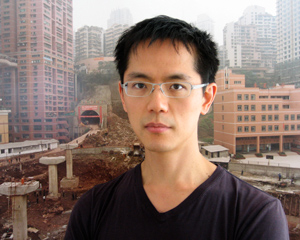
Of Sze Tsung Leong’s photographic series History Images—which exhibited in New York and Europe and has been published (Gottingen: Steidl, 2006) with text by Leong and Stephen Shore—David Frankel wrote in ArtForum this past September, “Nothing I have seen or read conveys more vividly the enormous change that China is undergoing.” Leong’s large-format, panoramic images depict crumbling tenements fringed around the eerily familiar skeletons of high-rises under construction. History Images frames the tragic beauty resulting from global modernism’s disdain for history and evinces all that recurs in Leong’s other works, including a series of oil paintings: the loss of historical space, the nuances and specificities of cities around the world, and the hierarchies represented by urban architecture. Leong’s essays have appeared in About Beauty, edited by Akbar Abbas and Wu Hung (Berlin: Haus der Kulturen der Welt, 2005), Art Journal, and ArtForum. Photographs from History Images appear in the recent publication On The Edge: Ten Architects From China (New York: Rizzoli, 2007), edited by Ian Luna.
I spoke to Leong at the Yossi Milo gallery in New York City, where his most recent solo exhibition of the History Images series was exhibited. Leong, a slight, soft-spoken man in wire-rimmed glasses, met me at the door of the gallery, a stark, wood-floored space in Chelsea. We walked through the gallery and examined many of the large-format history images, some of which are over three feet high, and which, seen up close, are of course even more compelling than the much scaled-down reproductions in his published monograph. As we examined the photographs, Leong pointed out details—wash hanging from a line, a glimpse of a domestic scene through an apartment window— that can best be appreciated in their original size. Leong is currently at work on a series called Cities, which documents urban environments all over the globe.
Interview by Josh Jones; Leong portrait photo by Judy Chung
Guernica: What drew you to these cities initially?
Sze Tsung Leong: The first time I visited China was in 1994, there was this strange sense of being both an insider and an outsider at the same time. Even though I am several generations removed from China, and even though I didn’t speak the language very well and was completely unfamiliar with the surroundings, I was immediately folded in to the culture. But I was fortunate to go there at that time because I got to see Beijing as it was changing. The second time I went was in 2001. I had been thinking about this project before, but that’s when I really decided to embark on the project because there was a great deal in the process of happening, a great deal to record.
Guernica: You mention recording: do you see these images, or any of your work, as documentary or journalistic in nature?

No. 3 Huashizhong Fourth Lane, Chongwen District, Beijing, 2003 C-Print © Sze Tsung Leong, Courtesy Yossi Milo Gallery
Sze Tsung Leong: I think labels apply only when talking about the specific uses of an image. The early large-format images taken by the mid- to late- nineteenth century photographers Felice Beato and John Thompson, which have been very influential on my work, were some of the first photographs taken of China. As historical records, they serve a documentary function, and when used in the newspapers at the time they served a journalistic function, but the life of an image is much more complex than its specific uses. My photographs certainly do document a period. They certainly record what’s going on, but what I have hoped to do is to portray larger themes—for instance, the destruction and creation of history; what it means for a culture to physically and historically self-destruct in this way—that go beyond the individual image.
History and modernization are not antithetical, but unfortunately in China they are usually seen that way.
Guernica: What is it that gets lost when history vanishes, when physical space is destroyed, specifically in the context of the Chinese cities you visited and photographed?
Sze Tsung Leong: History can be recorded in a myriad of ways: there’s a type recorded in books, but there’s also collective memory. You hear all the time that China has a 3,000 or 4,000 or 5,000 year old history—it varies between different numbers. History here becomes a symbol of cultural achievements and cultural pride and so on. You can see that in the monuments that are preserved and promoted, like the Great Wall and the Forbidden City. You can also see it in the list of inventions—gunpowder, fireworks, paper, bureaucracy, etc. So there’s that history that’s very well protected because it’s a matter of national identity. Then there’s the other type of history that is recorded in the fabric of cities. This includes the houses that are being destroyed; it has to do with the history of quotidian things, really, the layers of history that have slowly accumulated. The loss of this fabric—the spaces and histories particular to different cities—means that the particular cultural value and artistic qualities they contain, are lost.
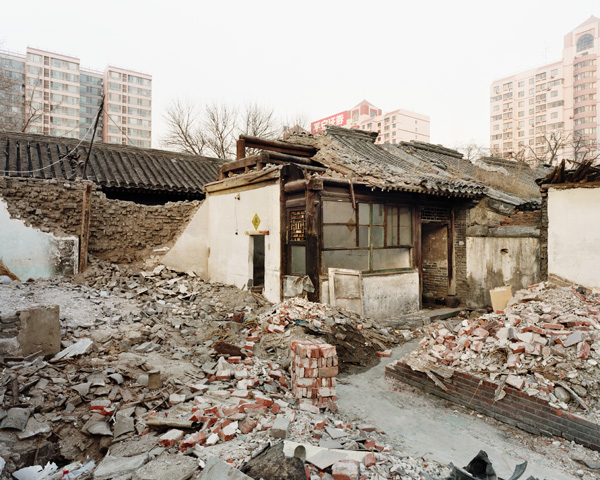
No. 6 Huashizhong Fourth Lane, Chongwen District, Beijing, 2003 C-Print © Sze Tsung Leong, Courtesy Yossi Milo Gallery
Guernica: Your images seem emblematic of the disenfranchisement of laboring people, people who aren’t necessarily beneficiaries of this new economic growth, and I wonder to what degree do class concerns inform your work? Is this something that you have in mind as you work on the Cities series, for example?
Sze Tsung Leong: Even though I do not specifically focus on the issue of class, I think the issue of class is inevitably a part of what I’m photographing. The buildings that are being destroyed, for instance the courtyard houses in Beijing, were originally built for wealthy families, but because of the revolution and different campaigns in China after the revolution, they became collectivized. Rather than one family living in one house, many families moved in because there was a campaign against the landowning classes that had owned these houses for many generations. Now, the houses are mostly inhabited by those who have been left behind by the economic revolution. Because the people who live there now don’t have the means to protect themselves, and because the legal system does not favor them, in most cases it has become an uneven battle between developers and government agencies on one side, and residents on the other. Of course the latter almost always lose.
But because of all the upheavals over the last half century and because of decades of state-sponsored disdain of history, these buildings have been extremely neglected. They’ve been classified in many cases as slums. There’s a whole official terminology that’s used to justify the erasure of these buildings. They’re called slums; they’re classified as dangerous and dilapidated, and that’s the terminology designed to influence opinion and it permeates this process.
Guernica: Do you see the organization of the series as a narrative, as telling a story?
Sze Tsung Leong: With a series of photographs the narrative aspect is usually clearest in books. But for me, when doing a photo book, it’s very difficult to say, “this is a complete narrative,” because the relationships between the images aren’t necessarily linear, going from front to back, but I have tried to set up relationships and themes, and also suggest change over time. Also, I have sequences where I suggest the disappearance of historic fabrics along with the emergence of new fabrics. This theme recurs several times but in the course of different images to suggest that there’s this cyclical development in China.
There were entire villages whose residents were moved to other parts of China, and there was one that was moved to Inner Mongolia, out in the middle of nowhere.
Guernica: Is there a centralized, concerted attempt at urban beautification on the part of the Chinese government or is development strictly commercially driven? Is there a grand plan for new urbanization?
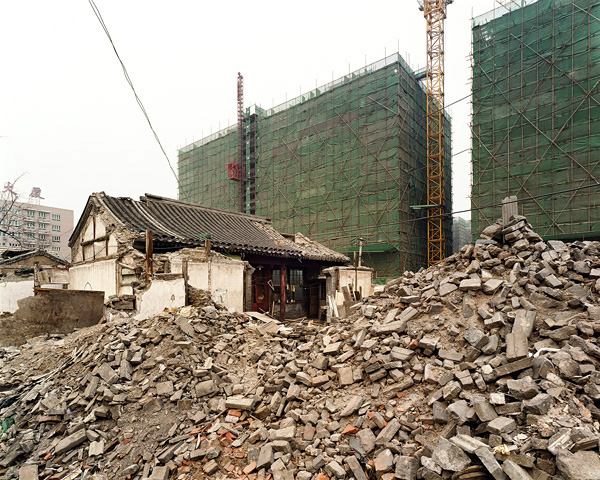
No. 15 Xiangluying Fourth Lane, Chun Shu, Xuanwu District, Beijing, 2004 C-Print © Sze Tsung Leong, Courtesy Yossi Milo Gallery
Sze Tsung Leong: China’s urban planning committees and central planning committees are good at grand plans. There’s a history of that in Chinese culture, because of China’s virtually uninterrupted history of centralized, totalitarian power that is able to carry out their plans. The Imperial cities were centered on the Emperor, and this tradition was continued by the Central Committee of the Communist Party whose plans sought to affirm the primacy of the State.
It’s important to remember that urban beautification, when sponsored and imposed by a ruling power, is a drive to make a statement to the public, and, most importantly, it is one of the forms by which state power is made acceptable and palatable. The way that the government presents itself and its ideologies to shape opinion has been at the core of the [Communist] Party since its inception, and the methods by which it does this evolve to suit the times. The workings behind communist-era propaganda and modern market- and media-driven publicity are not unrelated: witness the renaming of China’s “Central Propaganda Department” to the “Publicity Department.”
The most recent grand plan is for the Olympics, an ambitious makeover for Beijing that is designed to present a face of China that is acceptable and advanced, in the hopes that the world will focus on how beautiful, orderly and well-run the country is, instead of on the issues that China would rather the world not interfere with—human rights, the subjugation of non-Chinese cultures encircled by China’s political borders, its support of regimes like Sudan’s, the list goes on.
Today, much of the development is commercially driven, but there’s a fuzzy line between developers and the State, since the relationships between the two are so intertwined. This is why developers are able to gain control of such large urban areas, drive out all the residents, raze the entire area, and refashion these zones into profitable real estate. In Shanghai, there’s a development in one of the historic areas called Xintiandi, a hugely successful pedestrian shopping mall billed as a preservation project. The mall is built in the style of the traditional buildings that used to be there, and what was basically done is most of the original buildings were demolished, some of the buildings were restored but basically rebuilt. It’s become so hugely successful as a commercial enterprise because people are attracted to this old, historical, pedestrian type of city life, that now every city wants a Xintiandi. But what is important to remember is that the new “historic” area is only a very small portion, albeit the most famous one, of the entire development. Pretty much all of what was there before was destroyed and replaced by an entirely new reality, which is what you see all over China.
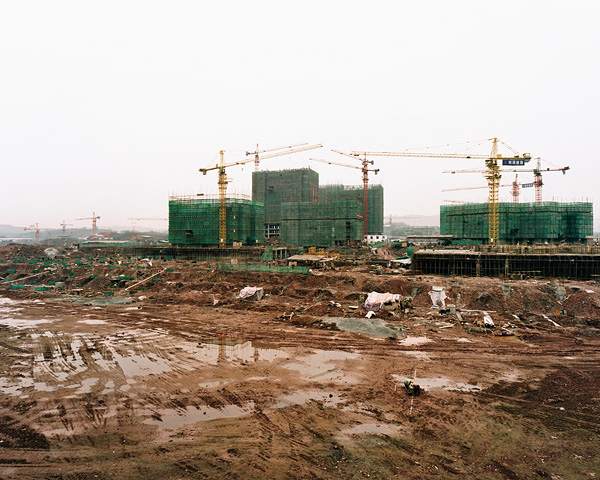
Xinnan Lu III, Beicheng Zhongxin, Jiangbei District, Chongqing, 2003 C-Print © Sze Tsung Leong, Courtesy Yossi Milo Gallery
Guernica: A New York Times reviewer described History Images as “beautiful, frightening, and sad.” How would you describe the experience of seeing this destruction and rebuilding firsthand? When it’s mediated in the photographs, it’s stark and it’s striking, but it’s also static. We don’t get to see the change over time—which of course you did, since you were there for over a year.
Sze Tsung Leong: I lived there for a year and a half, but this project was a total of four years during which I traveled there frequently. Every time I would arrive in China I would go through a few days of depression from being reminded of both short-term and long-term ruin; the ruining of the city that is happening in the short-term, and the ruining of culture and history that has happened over decades. It’s an emotional experience. When you see a building that says so much about the culture that built it being destroyed, there are a lot of emotions. You feel a lot of anger when you see a building being destroyed and realize that it’s just a small part of what’s going on in the entire country.
The paradox in China is that while some things change very rapidly, others don’t. The appearance of its cities may be entirely different, but the inner workings behind these changes still persist: the regulation of society, the hierarchies of power, the relationship of the individual to the majority. In my book I have attempted to give a sense not only of change over time, but also of the structures that persist. The change over time I have focused on occurs both during this current period and also over history. The first three images in the book are a condensed synopsis of China’s history, as reflected in its urban form—from the imperial period, to the socialist one, to the current market economy era— which suggests both what has changed as far as the appearance and scale of the cities, and what hasn’t, as far as the regulation and ordering of society.
I have attempted to give a sense of this enormity by photographing in most of the major cities in China—Beijing, Shanghai, Guangzhou, Nanjing, Chongqing—and by drawing parallels through depicting the destruction of their unique histories, and their replacement with a more standardized representation of the present. I also photographed in the Yangtze River area that was affected by the flooding [in the building of the Three Gorges Dam]. One of the cities I photographed over a period of time, Fengdu, was completely destroyed in anticipation of the flooding and replaced by a new city built on the other side of the river. So, the residents who could afford it moved to the new city and the residents who couldn’t, which is the story in all of China, stayed in their buildings until they were forced out. There were entire villages whose residents were moved to other parts of China, and there was even one that was moved to Inner Mongolia, out in the middle of nowhere.
You certainly feel a lot of anger when you see one building being destroyed and realize that it’s just a small part of what’s going on in the entire country.
Guernica: I’ve heard a description of the economic revolution in China as something that’s creating two Chinas, described by some economists as China “A” and China “B.” How do you experience this kind of bifurcation when you’re there?
Sze Tsung Leong: There are tremendous disparities being created by the changes, especially disparities in wealth. There are two Chinas being created, that of the poor, rural China, and the wealthy, urban China. Yet within the cities, which is what I mostly experienced, there are tremendous disparities in wealth, and these disparities are inevitably drawn along urban lines, with many of the poor living in the old, traditional areas, and the wealthy living in exclusive enclaves. But as the traditional areas are destroyed, the poor have to move out to the fringes of the city, while the land of their former homes is transformed into real estate for the wealthy, creating a further segregation.
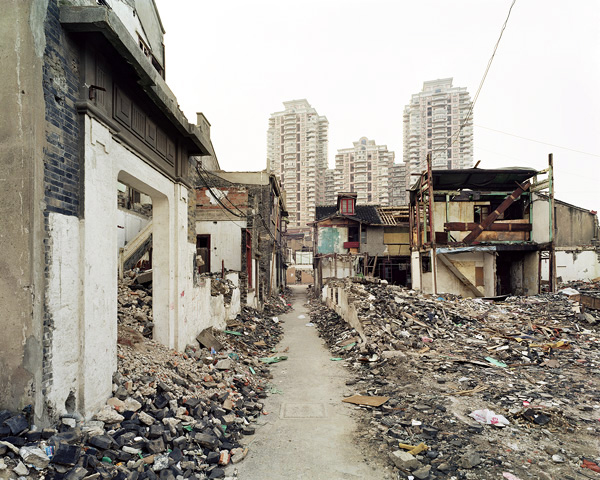
Daochuan Long, Nan Shi, Huangpu District, Shanghai, 2004 C-Print © Sze Tsung Leong, Courtesy Yossi Milo Gallery
There is also a cultural issue, and you could say it’s an Asian cultural issue because you see it also in Japan, which is that the old isn’t necessarily desirable. Actually the word for “old” in Chinese is commonly used in a pejorative way. But even though there is such a drive for modernization and an indifference to history, there are of course people who do see the cultural value of these old fabrics, and they’re mostly the older generations who would say, “this is the identity of our cities, this is the identity of China. We’re losing this.
Guernica: This also splits along generational lines.
Sze Tsung Leong: It does.
Guernica: Then families in the country are losing their younger men and women to the cities, similar to England’s Industrial Revolution? In that period, the older people who stayed behind became the guarantors of whatever was left of the heritage that was greatly important to them.
Sze Tsung Leong: You’re absolutely right. To a great extent they are similar trends.
Guernica: What’s really fascinating in looking at some of the photographs is the rapid move from this horizontal layout to the vertical, which seems antithetical to the traditional way of organizing domestic space in China. It’s reminiscent of urban renewal in 1960s New York City, where you had brownstones and row houses suddenly turned into massive apartment blocks and project housing. How does this reorganize the social fabric? Did you get a chance to see how living arrangements are ruptured?
Sze Tsung Leong: It has a tremendous effect. In China the courtyards and the streets that structured private houses served important social functions. Around the courtyard were arranged several structures within which different members of the family would live, from the patriarch in the main structure, to other members arranged hierarchically in the other structures. The houses then faced narrow streets, whose scale accommodated the more public social functions. But while family structures have changed, the remarkable thing about the courtyards and alleys is that they are so open to different uses, and can be very vibrant places because of their scale. That’s one of the biggest casualties of the new development.
Guernica: The loss of that public space?
Sze Tsung Leong: Yes. New public space is emerging, but with virtually no relationship to its predecessor. It’s much vaster and more exposed, and is usually the space remaining between very large structures. I guess these new spaces are historically specific in the way that the [older] buildings are historically specific to China, but the new high-rise developments certainly follow a more global pattern.
Guernica: I love the way that all of the minutiae of city life becomes visible in your large format images.
Sze Tsung Leong: I like using the large format camera because it records so much and there’s a lot of information that you end up seeing. You get, for instance, a sweeping urban scene as well as the washing hanging in the windows.
Guernica: One thing that really stands out for me is almost the complete absence of people in many of the photographs; they appear occasionally. I wonder if this was a choice that you made or if these areas are deserted in many instances.
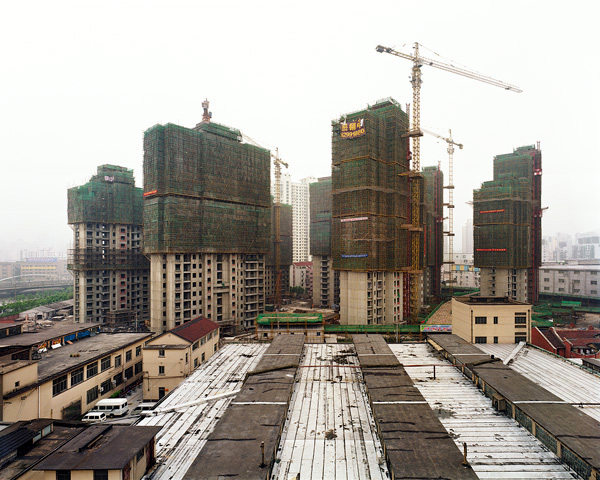
Moganshan Lu, Putuo District, Shanghai, 2004 C-Print © Sze Tsung Leong, Courtesy Yossi Milo Gallery
Sze Tsung Leong: There are a couple of reasons for that. In many of the areas I was photographing, which are areas in transition, either being destroyed or built, there actually aren’t very many people; either the people have left or it hasn’t been inhabited yet. There’s another factor which is because I’m using a wide-angle lens, trying to capture as much of the environment as possible, people are shown in proportion to the larger environment, so in some images you’ll see a lot of people but they’ll just be very small because the environment’s so vast. And also sometimes my exposures are very long, so people either come out as blurs or, in very long exposures, they’ll all but disappear. But for me you don’t need to see people in order to feel their presence.
Cities in China are becoming increasingly uniform, increasingly designed around sustaining the engine of the market by creating the framework for a consumer-oriented society.
Guernica: I wonder why you’re primarily drawn to urban landscapes over natural, and what the images of urban spaces conceal or reveal about the countries you are visiting?
Sze Tsung Leong: I think the distinction between natural and man-made in China is quite artificial, since there’s a history of designing the landscape and making it a purposeful construct. It’s not necessarily that I’m drawn to the urban over the natural, but that the urban is a dense repository of information about history, the structures that influence and form our lives, and the cultures that leave their mark on places.
There’s also a personal aspect. My current work, where I’m photographing landscapes and cities in different places throughout the world, is to a large extent shaped by my experience growing up in Mexico, with parents from England and Malaysia, having British and now American citizenship, and being of Chinese ancestry—so this has formed a particular sense of belonging to the world, and an interest in seeking the connections and relationships between places. And my work in China did have a lot to do with the fact that my ancestry is Chinese. There was this sense of urgency to find out about what was going on in the country, and to see what was being made of history, because I had this history that’s been a part of me growing up. I wanted to see what was actually going on.
Guernica: Has there been some attempt to update and yet preserve some traditional urban structures that are still structurally sound?
Sze Tsung Leong: There has been, and there are some really great examples of that, but only in extremely rare instances—buildings preserved in ways that retain part of the history but then modernize it, or new projects that interpret history in a completely modern way. Yet the tragedy is that the majority of modernization is carried out in a very unintelligent and brutal way, with significant consequences for history. History and modernization are not antithetical, but unfortunately in China they are usually seen that way.
It’s also important to note that preservation in China has a very different meaning. Usually what happens is that when a building or an area is preserved, it is torn down and replaced with a new structure, then painted to look like new.
Guernica: I wonder if you see a new kind of beauty emerging in these brand new cities. In “The Authority of Beauty,” you write, “unplanned beauty emerges out of an organic process of growth, where a city or town reaches a state of aesthetic or cultural harmony, not through any willful design.” Here, it seems we have the most willful of designs and the most rapid of building processes. Does this, in a sense, foreclose the possibility of beauty, since you have a precise conception of what beauty means in an urban context?
Sze Tsung Leong: I wrote about two types of beauty, one that is singular, planned, and imposed, the other that is manifold, unplanned, and accumulated slowly over time through historical layering. It’s this second type that is being destroyed in Chinese cities through the narrowing of history in order to build the present. Now, since China is in transition, there are still places where you can see a layering of history, but as these get destroyed, and others “preserved”—that is, rebuilt so that they become a very specific idea from the present of what the past should be—they become rarer and rarer.
Hu Jintao is now instructing the country to build a “harmonious society,” an umbrella concept that is related to this singular, planned idea of beauty, and that encompasses all the trends China has been pushing for: channeling society into the dominant idea of how it should be organized, unifying culture at the expense of contradiction and difference, and directing opinion at the expense of dissent. I experienced one manifestation of this harmonious society in Inner Mongolia, where I ate at a Mongolian restaurant whose attendants, all Chinese, in Mongolian dress, were singing “I am a Mongolian,” in Chinese. And this push for harmony translates into the shape of China’s cities. Cities in China are becoming increasingly uniform, increasingly designed around sustaining the engine of the market by creating the framework for a consumer-oriented society.
I don’t, however, think the possibility for beauty can be foreclosed, because beauty can take so many forms. I’ve only talked about two forms. There is beauty that arises from the unexpected, when our familiar perspectives are thrown off balance. There is also the beauty that paradoxically comes out of the tragic, that emerges because we are reminded of what is no longer there, that becomes powerful because of what is absent.
To comment on this piece: editors@guernicamag.com

